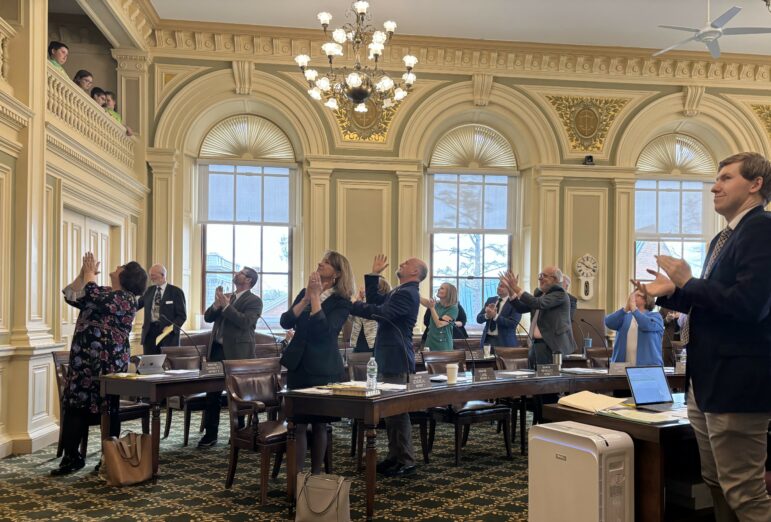Power to the People is a column by Donald M. Kreis, New Hampshire’s Consumer Advocate. Kreis and his staff of four represent the interests of residential utility customers before the NH Public Utilities Commission and elsewhere.
DONALD M. KREIS, Power to the People
Four years and (for reasons I will explain) more than a few dollars short, the state’s Department of Energy has finally finished its long awaited “Value of distributed Energy Resources” (VDER) study. It is a big deal.
You may have noticed – I certainly have – that since well before I took office as New Hampshire’s Consumer Advocate in 2016, much of the debate about energy in the Granite State has focused on net metering. There is something about spinning your electric meter backwards (metaphorically, if you have a digital meter) that captures the imagination and, in some circles, inspires outrage.
And, yet, everyone in New Hampshire has the right to put solar panels on their roofs or in their backyards, use the output to replace energy sucked off the electricity grid, and feed the surplus back into the grid for fun and profit. The question is: How much profit?
Way back in 2016, the Legislature gave the Public Utilities Commission ten months to figure that out – i.e., to determine what price to pay net metering customers for their output so as maximize net benefits and avoid “unjust and unreasonable cost shifting.” Thus the Commission’s net metering order of June 23, 2017.
The Commission’s 2017 order is best characterized as a form of rough justice. Specifically, the PUC decided that net metering customers should be paid most but not all of the energy, transmission and distribution charges in their utility’s retail rate. The haircut, for net metering customers, involved the credit for distribution charges being reduced to 25 percent of those charges.
This, the PUC made clear, was just a temporary, placeholder solution to the problem of how much to pay for net metered electricity. To come up with a long-term approach to net metering, the Commission agreed with virtually all parties and announced that it would commission a VDER study to figure out, definitely, what net metered electricity is truly worth.
The PUC gave its staff (which has since been split off to become the regulatory support division of the new Department of Energy) eight months to come up with a timeline. That didn’t happen.
In fact, the Commission did not issue an order approving the scope of the VDER study until December 18, 2019. At that point, the Commission specified that the VDER study should be finished by mid-2021. Then, in February of 2021, the Commission yet again extended the deadline, this time to March 31, 2022.
Then (to quote John Milton in Paradise Lost), all hell broke loose. In fact, it happened three times.
First, the pandemic struck in March 2020, bringing all progress on any front anywhere to a halt. Then, in June of 2021, the Legislature decided to scramble energy regulation in New Hampshire by creating the Department of Energy and divest the PUC of its advocacy staff. Finally, Vladimir Putin invaded Ukraine in February 2022 and that sent energy prices spiraling upward to the stratosphere.
Dunsky Associates – the Canadian consulting firm hired to perform the VDER study – is partying like it’s 2021. That’s my takeaway from the slide deck the study’s authors presented to stakeholders on September 28.
According to Dunsky, a “technology neutral” assessment of the value of net metered energy to the grid in New Hampshire would bring you to a figure of 15 cents per kilowatt hour for 2021. The number goes down to 10 cents if you eliminate the value of environmental impacts. The number goes up to 17 cents in 2035.
That’s substantially less than the net metering credit Eversource customers are reaping today, given the default energy service rate of 22.6 cents.
“These results are predicated on assumptions that aren’t grounded in the current energy markets,” admitted Senior Consultant Claire Cameron of Dunsky. She noted that when the full report is submitted to the PUC next month, it will include a “live” edition of their valuation model so that anyone interested can manipulate it to reflect changing market conditions.
Some good news for fans of solar power: Dunsky’s value number for net-metered solar power goes up somewhat if you apply the effects of changing hourly demand and the sun’s progress across the horizon. A solar panel array facing west carries a value of 22 cents in 2021. But that estimate goes down to 18 cents in 2035.
Does that mean that if you build a new net metering array you should make sure it faces west, to capture lots of rays in the late afternoon when demand for power on the grid is highest? Not necessary. A south-facing array will produce more energy overall.
Even more noteworthy, perhaps, is Dunsky’s assessment of bill impacts of the current net metering rate from 2021 to 2035. For an Eversource customer, net metering reduces monthly bills by more than 92 percent. Yes, that high!
For everyone else – Eversource customers who don’t participate in net metering – bills increase by one percent.
What’s the significance of that? Well, remember that New Hampshire law does not prohibit the shifting of costs between net metering and non-net metering customers. It just instructs the PUC to eliminate any “unreasonable” cost shifting.
Is that one percent increase unreasonable? You decide.
I think it might okay, from a cost-shifting perspective, especially given the number of people who have been calling me lately and asking what they can do about their ballooning electric bills. To avoid leaving people behind, there is group net metering (including projects specially subsidized to attract people of modest means).
For a typical residential customer of Eversource, using 650 kilowatt-hours a month, the all-in cost of electricity is slightly more than 34 cents. It is disappointing, to say the least, that the folks from Dunsky could not find a way to provide some analysis of how net metered energy should be valued, and what bill impacts would result, from the current era of ridiculously high default energy service prices. Unitil just proposed raising theirs to 26 cents as of December 1, which officially places them in the realm of the unaffordable.
Presumably that makes the case for net metering more compelling than it was in 2017. It is hard to say, though, given the number of moving points. It is not just a matter of adding the latest price increases to the bill savings or avoided costs.
It was also disappointing to hear the answer from the Department of Energy when it was asked, point blank, whether the report puts the question of unreasonable cost shifting to bed once and for all. “We should let the Dunsky report speak for itself, when it is issued,” said David Wiesner, director of the Department’s legal division.
The Department invited public comment on the presentation it made on September 28. But both the department and Dunsky made clear their substantive work is done. Now it’s just a matter of how to spin them – or, at least, how to write them up.
The PUC plans to take up the question of how to revise net metering rates beginning in early 2023. With any luck, it will mark the end of the perpetual arguing about net metering so we can all turn our attention to bigger problems.





